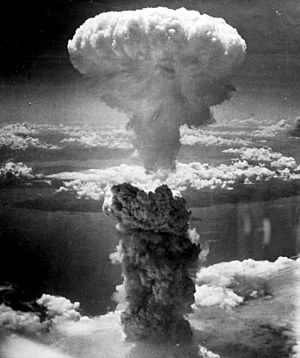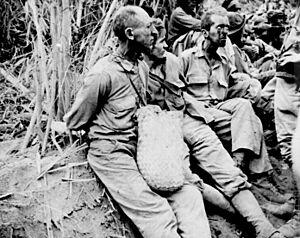Joe Kieyoomia facts for kids
Quick facts for kids
Joe Kieyoomia
|
|
|---|---|
| Birth name | Joe Lee Kieyoomia |
| Born | November 21, 1919 |
| Died | February 17, 1997 (aged 77) |
| Buried |
San Juan County, New Mexico
|
| Allegiance | |
| Service/ |
|
| Rank | Sergeant |
| Unit | 200th Coast Artillery |
| Battles/wars | World War II
|
| Awards |
|
Joe Kieyoomia (born November 21, 1919 – died February 17, 1997) was a Navajo soldier from New Mexico. He served in the 200th Coast Artillery unit during World War II. In 1942, he was captured by the Imperial Japanese Army after the Philippines fell.
Joe Kieyoomia became a POW, which means "prisoner of war." He was held in Nagasaki when the city was hit by an atomic bomb. Amazingly, he survived this huge explosion. Reports say the strong concrete walls of his prison cell protected him.
The Japanese tried to make him understand secret messages in the "Navajo Code" used by the United States Marine Corps. Even though Kieyoomia spoke Navajo, the messages sounded like nonsense to him. This was because the code was very special. Only people trained in its specific use could understand it.
Joe Kieyoomia is famous for surviving many terrible events. He lived through the brutal Bataan Death March and harsh time in a prison camp. He also became a hibakusha, a Japanese word for a survivor of an atomic bomb blast.
Capture in the Philippines
During World War II, the fight for Bataan in the Philippines was very important. It helped slow down the Japanese army. This gave the Allies, including the United States, valuable time. They used this time to get ready for other big battles. These included the Battle of the Coral Sea and the Battle of Midway.
After the fighting, Joe Kieyoomia was captured. He was among more than 60,000 Filipino and 15,000 American soldiers. These prisoners were forced to march in the terrible Bataan Death March.
Life as a Prisoner of War

Joe Kieyoomia's captors thought he was Japanese-American. They believed he was a traitor. Because of this, he suffered harsh treatment and beatings for months. Eventually, the Japanese accepted that he was Navajo.
He survived the Death March, where thousands of starved American and Filipino soldiers died. Later, the Japanese were confused by the "Navajo Code." They questioned Kieyoomia about it. He did not even know the code existed. He could only understand small parts of what the Navajo Code Talkers were saying. He told the Japanese that it sounded like nonsense to him.
Because he could not crack the code, he was punished. He was made to stand in the freezing cold for hours.
After surviving the prison camps, dangerous "hell ships," and difficult conditions, Kieyoomia was a prisoner in Nagasaki. This city became the target of the second atomic bomb. It was dropped by the U.S. Army Air Forces. Kieyoomia survived the attack. He said the strong concrete walls of his cell protected him.
He was a prisoner of war for three and a half years. After the bombing, he was left in the city for three days. Finally, a Japanese officer freed him.
Later Life and Death
After the war ended, Joe Kieyoomia returned to the United States. He recovered from his injuries. His wounded leg healed, and he regained its use. He lived to be 77 years old, passing away in 1997.
See also


